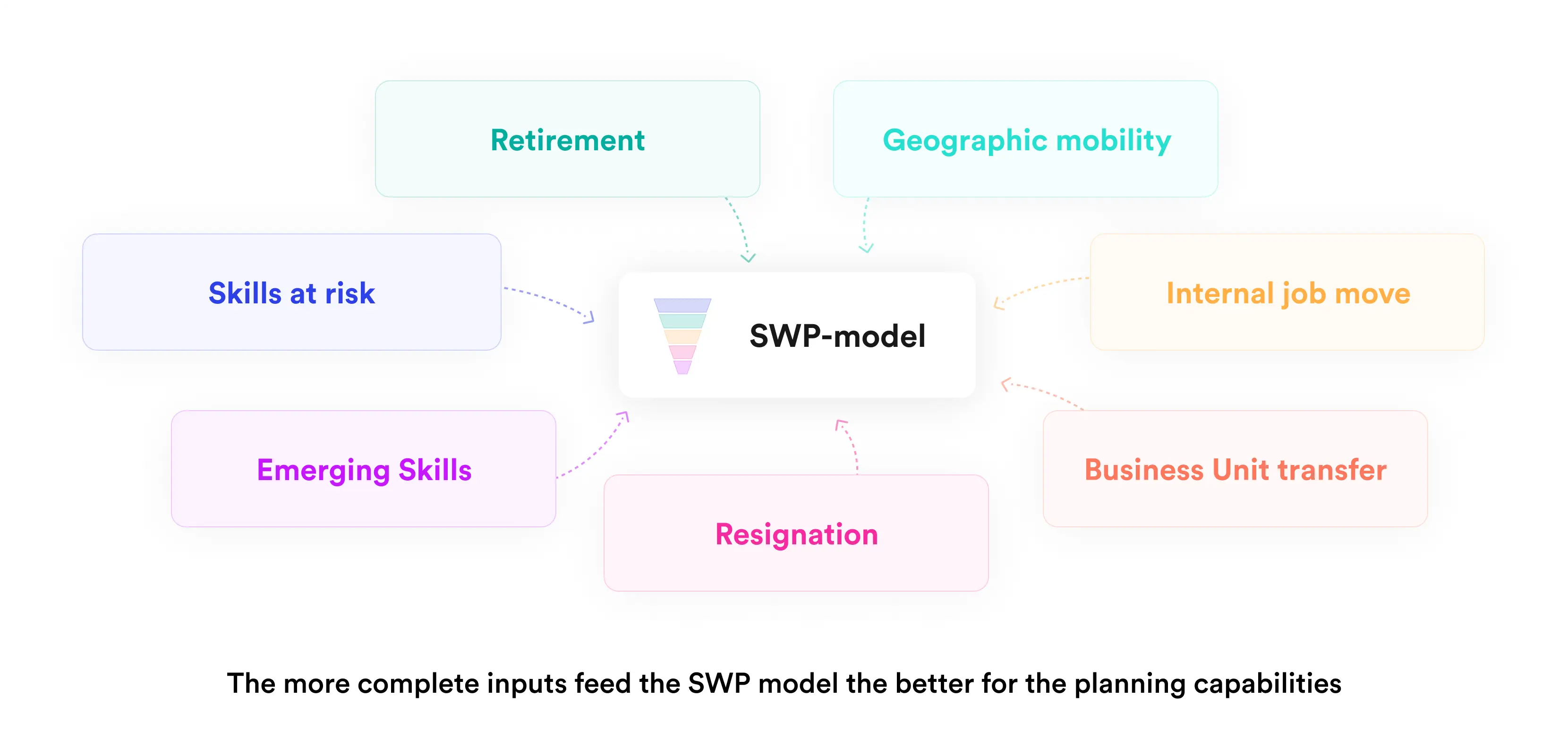The Strategic Workforce Planning (SWP) or in French “Planification Stratégique des Effectifs” (Strategic Workforce Planning) is the subject of much discussion and interest, if not enthusiasm. Indeed, the promise is tempting because this approach aims to reduce the permanent uncertainty and to predict the skills risks. This first section dedicated to Human Capital Management is dedicated to understanding and illustrating this decision-making tool.
Strategic Workforce Planning: what definitions?
The Strategic Workforce Planning is an operational guide for HR decision making in achieving its objectives. It also represents a trigger for collaboration between the main departments thanks to the exploitation of every information contained in the organization.
Let’s explore these 3 dimensions further:
The common thread of HR action in the face of strategic needs
The SWP is assimilated to the HR management control and constitutes the link between the functional, financial and HR departments of the company. This collective process requires the collection of various data in a single intelligent analysis platform. Today, it represents the most successful collaborative planning tool in a random environment.
The operational leverage of the organization’s priorities
Workforce Planning is defined as a device for optimizing the allocation of resources and skills of the company. The planning of skills has temporal (when), functional (where in the organization) and financial (what costs are associated with each option selected) dimensions.
The HR Data Catalyst
Organizations use data on employment trends, skills in demand in the labor market. This data is supplemented by economic estimates to predict the key skills and professionals they will need in the future.
These assumptions are used to guide their workforce planning. Strategic workforce planning also determines the areas where it will be necessary to recruit new employees or train existing employees to acquire the necessary skills.
By using forecasting as an integral part of their operational programming process, organizations can be better prepared to meet the challenges and opportunities they face.
SWP vs Jobs & Skills Management : What are the differences?
The Strategic Workforce Planningand then the Jobs & Skills Management have been trying for 25 years to substitute a proactive approach to a reactive behavior in human resources management. Contrary to Jobs & Skills Management, the SWP provides the operational modeling of the means to anticipate the various changes in the company. This device shows an immediate relationship to time and a more efficient response to business objectives.
Let’s break downthese 2 differences:
Temporal differences
The Jobs & Skills Management has the virtue of anchoring an increased focus on the anticipation of needs in the broadest sense, but it remains too static with its 3-year cycle. The rapid transformations experienced by companies require a much more regular dynamic than a plan and means reviewed on a three-year basis. This is why the SWP focuses on responding to uncertainties through an iterative process based on scenarios. Since planning for the future involves uncertainties, the approach is as follows:
- Consider several assumptions about the “supply” or availability of resources and skills. For example: the realization of a strategic plan with an isolated workforce.
- Establishdifferent options vis-a-vis the “demand”, the need for resources or qualifications. For example: 10% of the jobs will be new, to be created.
- To deduce the gap and the possible options: mobility, outsourcing, recruitment
- Calculate the financial impact of each scenario.
This pathway is continually reviewed as the initial hypotheses are realized. It is also fed by the history and behaviors of the population concerned throughout its lifetime.
Differences in implementation
The Jobs & Skills Management is most often put in place for its legal and binding dimension, so it is more commonly considered from an administrative perspective. We see a risk of focusing HR planning on Jobs & Skills Management alone. Too often this is done to demonstrate the good will of the social partners to commit to a sterile action plan.
Unlike Jobs & Skills Management , which is limited to an essentially administrative perspective, this device has a decidedly business orientation.
Today, companies use excel to move units, not employees, with all their assets. The Jobs & Skills Management allows to anticipate retirements in the best of cases, while there are many other priorities:
- Redeploy skills to critical locations in the organization
- Arbitrating between recruitment and mobility by benchmark jobs
- Observe the skills towards which employees are moving in order to identify the professions at risk of desertification.
The SWP can even include a sequencing dimension with which companies influence the course of things, for example: from the acquisition of know-how to its redeployment in other departments or businesses.
A Practical Example of Implementing Strategic Workforce Planning
Manage the jobs in tension with the SWP
Nothing better than a practical case to illustrate the performance of the Strategic Workforce Planning, let’s start on the job of Data Scientist.
The context of the job in tension of Data Scientist
With the ambitious digital transformation plans undertaken by companies, the job of Data Scientist is one of the most sought-after positions. In 2021, 250,000 job offers for a Data Scientist went unanswered (according to QuantHub). And this is not going to stop, as the number of job openings is expected to increase by 15% per year until 2029 (according to the Bureau of Labor Statistics)
How a predictive engine works for this business
Let’s take the case of a company that, with the COVID crisis, has maintained a stable workforce. Its team of Data Scientists consists of 6 people. It is decided that only departures are replaced. By default, the SWP algorithm reproduces this iso-staffing replacement scenario over the next few years.
Consequences on seniority and level of technical know-how
The algorithm maintains the same number of employees while compensating for departures with new employees. This results in a decrease in the seniority of the team. The theoretical skills of Data Scientists are unchanged since the new talents recruited have the only skills required for the position.
What if the goal is to double the team’s size by 2025?
An advanced Strategic Workforce Planning solution allows you to create different scenarios to achieve this goal by 2025, for example:
- Decrease the number of departures each year,
- Increase the number of hires.
- Use freelancers
- To encourage mobility to this department
Such an approach offers the ability to break down the acquisition levers and to deduce the costs and time required for each method. In addition, the Human Resources Department has the level of seniority targeted over the next three years linked to the gradual increase in the workforce. Finally, this approach cannot be successful without a global view of the number of employees with skills close to the data scientist profession. This will enable us to anticipate other mobility or acquisition scenarios depending on the origin of the transfer of resources to Data Science.
To conclude, the planning tool that constitutes Strategic Workforce Planning allows us not to be subjected to events and to be able to react thanks to its modeling of the different scenarios. It is also important to engage in an ongoing process that is regularly reviewed to consider societal and economic changes such as the emergence of freelance status. It is also important to consider long-term trends, such as demographic changes and technological developments to ensure that human resource needs are met in the short and medium term.
Finally, encouraging innovation and personal growth through effective talent development programs is critical to successful strategic workforce planning. Ultimately, in a talent shortage environment, the goal is to ensure that employees feel valued and appreciated.








